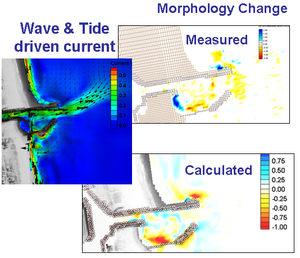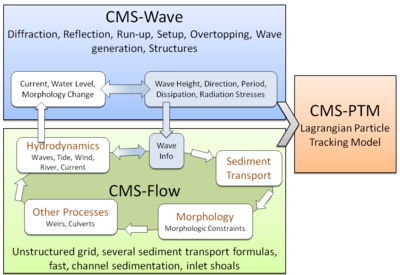CMS: Difference between revisions
m 16 revisions: Import from Fault |
mNo edit summary |
||
| Line 39: | Line 39: | ||
The CMS-PTM is a Particle Tracking Model capable of introducing and following the trajectory of discrete particles in the flow field. The PTM model is useful for determining sediment pathways, residence times, etc. For more information on CMS-PTM visit [[CMS-PTM | CMS-PTM Main Page]] | The CMS-PTM is a Particle Tracking Model capable of introducing and following the trajectory of discrete particles in the flow field. The PTM model is useful for determining sediment pathways, residence times, etc. For more information on CMS-PTM visit [[CMS-PTM | CMS-PTM Main Page]] | ||
br style=clear:both / | br style=clear:both / | ||
== Documentation Portal== | |||
{|class="main" width="99%" | |||
|style="vertical-align:top;width:33%" | <!-- Left Column Portal --> | |||
===Technical Documentation=== | |||
---- | |||
*Hydrodynamics | |||
**[[CMS-Flow:Hydro_Eqs|Governing Equations]] | |||
**[[CMS-Flow:Bottom_Friction|Bottom and Wall Friction]] | |||
**[[CMS-Flow:Eddy Viscosity|Eddy Viscosity]] | |||
**[[CMS-Flow:Wind_Pressure|Wind and Atmospheric Pressure]] | |||
**[[CMS-Flow:Boundary_Conditions|Boundary Conditions]] | |||
*[[Sediment Transport]] | |||
**[[CMS-Flow:Equilibrium Total Load|Equilibrium Total Load]] | |||
**[[CMS-Flow:Equilibrium Bed load plus AD Suspended load|Equilibrium Bed load plus AD Suspended load]] | |||
**[[CMS-Flow:Non-equilibrium_Sediment_Transport|Total load Non-equilibrium Sediment Transport]] | |||
**[[CMS-Flow:Transport Formula | Sediment Transport Formula]] | |||
*[[CMS-Flow:Roller | Surface Roller]] | |||
*[[CMS-Flow:Salinity_Calculation|Salinity Transport]] | |||
*[[CMS-Flow:Structures|Structures]] | |||
*Waves | |||
** [[CMS-Wave:Governing_Equations|Governing Equations]] | |||
<!--** [[CMS-Wave:Breaking|Breaking]]--> | |||
** [[CMS-Wave:Diffraction|Diffraction]] | |||
<!--** [[CMS-Wave:Wave_Generation|Wave generation]]--> | |||
** [[CMS-Wave:Wave-current_Interaction|Wave-current interaction]] | |||
<!--** [[CMS-Wave:Wave-wave_Interaction|Wave-wave interaction]]--> | |||
*[[Model Coupling | Coupling of CMS-Flow and CMS-Wave]] | |||
*Model Angle Conventions | |||
** [[CMS-Wave Angle Conventions|CMS-Wave]] | |||
** [[CMS-Flow Angle Conventions|CMS-Flow]] | |||
|style="vertical-align:top;width:33%;border-left:1px solid #aaa;padding-left:1em"| <!-- Middle Column Portal --> | |||
===User Guide=== | |||
---- | |||
*[[Getting Started]] | |||
*[[Tutorials|CMS Tutorials]] | |||
*[[Tutorials:SMS|Related SMS Tutorials]] | |||
*[[Frequently Asked Questions]] | |||
*[[CMS-Flow:Grid_Generation|Grid Generation]] | |||
<!--*[[CMS-Flow:User_Guide_Stuctures|Structures]]--> | |||
'''CMS-Flow''' | |||
*Hydrodynamics | |||
**[[CMS-Flow Model Parameters|Model Parameters]] | |||
**[[CMS-Flow Boundary Conditions|Boundary Conditions]] | |||
**[[CMS-Flow Bottom Friction|Bottom and Wall Friction]] | |||
**[[CMS-Flow Eddy Viscosity|Eddy Viscosity]] | |||
**[[CMS-Flow Wind Forcing|Atmospheric Forcing]] | |||
**[[CMS-Flow Wave Forcing|Wave Forcing]] | |||
*[[CMS-Flow Sediment Transport|Sediment Transport]] | |||
**[[CMS-Flow Sediment Transport#Total Load Equilibrium Transport |Total Load Equilibrium Sediment Transport]] | |||
**[[CMS-Flow Sediment Transport#Equilibrium Bed Load Plus AD Suspended Load|Equilibrium Bed Load Plus AD Suspended Load]] | |||
**[[CMS-Flow Sediment Transport#Total load Non-equilibrium Sediment Transport|Total load Non-equilibrium Sediment Transport]] | |||
**[[CMS-Flow Sediment Transport#Hard_Bottom | Hard Bottom]] | |||
**[[CMS-Flow Sediment Transport#Variable_D50 | Variable D50 Dataset]] | |||
**[[CMS-Flow Multiple-sized Sediment Transport | Multiple-sized Sediment Transport (Advanced) ]] | |||
* [[CMS-Flow Salinity Transport|Salinity Transport]] | |||
**[[CMS-Flow Salinity Transport#Salinity Concentration Forcing|Boundary Conditions]] | |||
**[[CMS-Flow Salinity Transport#Salinity Initial Concentration|Initial Condition]] | |||
* [[CMS Surface Roller | Surface Roller]] | |||
* [[CMS-Flow:Features#Other_Features|Other Features]] | |||
* [[CMS:CardList:Flow | List of all Flow Cards ]] | |||
'''CMS-Wave''' | |||
*[[CMS-Wave Grid Generation | Grid Generation]] | |||
*[[CMS-Wave Model Parameters | Model Parameters]] | |||
*[[CMS-Wave Input Spectra | Input Spectra]] | |||
*[[CMS-Wave Structures | Structures]] | |||
*[[CMS-Wave Features | Other Features]] | |||
'''[[CMS-Flow and CMS-Wave Model Coupling | CMS-Flow and CMS-Wave Model Coupling]]''' | |||
|style="vertical-align:top;width:33%;border-left:1px solid #aaa;padding-left:1em"| <!-- Right Column Portal --> | |||
===Examples, applications and more=== | |||
---- | |||
*[[Test Cases]] | |||
*Applications | |||
**[[Previous Projects]] | |||
**[[Current Projects]] | |||
*[[Utilities]] | |||
*[[Links | Useful links]] | |||
*[[Glossary]] | |||
*[[References]] | |||
*[[User Group]] | |||
*[[Special:AWCforum | CIRPwiki Forum]] | |||
'''Workshops''' | |||
* [[Workshops:MVN2010 | New Orleans CMS/CPT Workshop 2010]] | |||
|} | |||
---- | |||
== Documentation Portal== | == Documentation Portal== | ||
Revision as of 22:04, 8 September 2011
Coastal Modeling System

An Advanced Engineering Tool
The Coastal Modeling System is an integrated suite of numerical models for simulating flow, waves, sediment transport, and morphology change in coastal areas. The system is designed for practical applications in navigation channel performance and sediment management for coastal inlets and adjacent beaches in order to improve the usage of USACE Operation and Maintenance Funds. The CMS is intended as a research and engineering tool that can be used on desk-top computers. The CMS takes advantage of the Surface-water Modeling System (SMS) interface for grid generation and model setup, as well as plotting and post-processing. br style=clear:both /
- Background
The CMS has been a research and development area of the Coastal Inlets Research Program (CIRP) at the United States Army Corps of Engineers - Engineering Research and Development Center (USACE-ERDC), Coastal and Hydraulics Laboratory (CHL) since 2006. It was built from a group of numerical models that have been under development since 2002. Information on the CIRP and publications on the CMS can be found at the CIRP Website.
- Key Features
- Fully integrated system
- Finite Volume Method - Mass conservative
- Non-uniform Cartesian Grid - Easy to setup and run
- Supports most common types of forcing and boundary conditions
- Robust numerical schemes for reliable, crash-free simulations
- Parallelization on desktop computers for fast computation
- User-friendly interface
System Components

CMS-Flow is a coupled hydrodynamic and sediment transport model capable of simating depth-averaged circulation, salinity and sediment transport due to tides, wind and waves. The hydrodynamic model sovles the conservative form of the shallow water equations and includes terms for the Coriolis force, wind stress, wave stress, bottom stress, vegetation flow drag, bottom and friction, and turbulent diffusion. There are three sediment transport models available in CMS: a sediment mass balance model, an equilibrium advection diffusion model, and non-equilibrium advection-diffusion model. The salinity transport is simulated with the standard advection diffusion model and includes evaporation and precipitaion. All equations are solved using the Finite Volume Method on a non-uniform Cartesian grid. For additional information on CMS-Flow visit CMS-Flow Main Page.
The CMS-Wave is a spectral wave transformation model and solves the steady-state wave-action balance equation on a non-uniform Cartesian grid. It considers wind wave generation and growth, diffraction, reflection, dissipation due to bottom friction, whitecapping and breaking, wave-wave and wave-current interactions, wave runup, wave setup, and wave transmission through structures. For additional information information on CMS-Wave visit CMS-Wave Main Page.
The CMS-PTM is a Particle Tracking Model capable of introducing and following the trajectory of discrete particles in the flow field. The PTM model is useful for determining sediment pathways, residence times, etc. For more information on CMS-PTM visit CMS-PTM Main Page br style=clear:both /
Documentation Portal
Technical Documentation
|
User GuideCMS-Flow
CMS-Wave |
Examples, applications and more
Workshops |
Documentation Portal
!-- Left Column Portal --
Technical Documentation
|
--** Breaking-- | --** Wave generation-- | --** Wave-wave interaction--
|
!-- Middle Column Portal --
User Guide |
--*Structures--
CMS-Flow
CMS-Wave |
!-- Right Column Portal --
Examples, applications and more
Workshops Downloads
|
|---|
External Links:
- US Army Engineer Research and Development Center - Ongoing Research [1]
- Presentations (MVN Workshop - June 2009)
- Aug 2008 Two-Dimensional Depth-Averaged Circulation Model CMS-M2D: Version 3.0, Report 2, Sediment Transport and Morphology Change [7]
{{#rawmsg:back}}